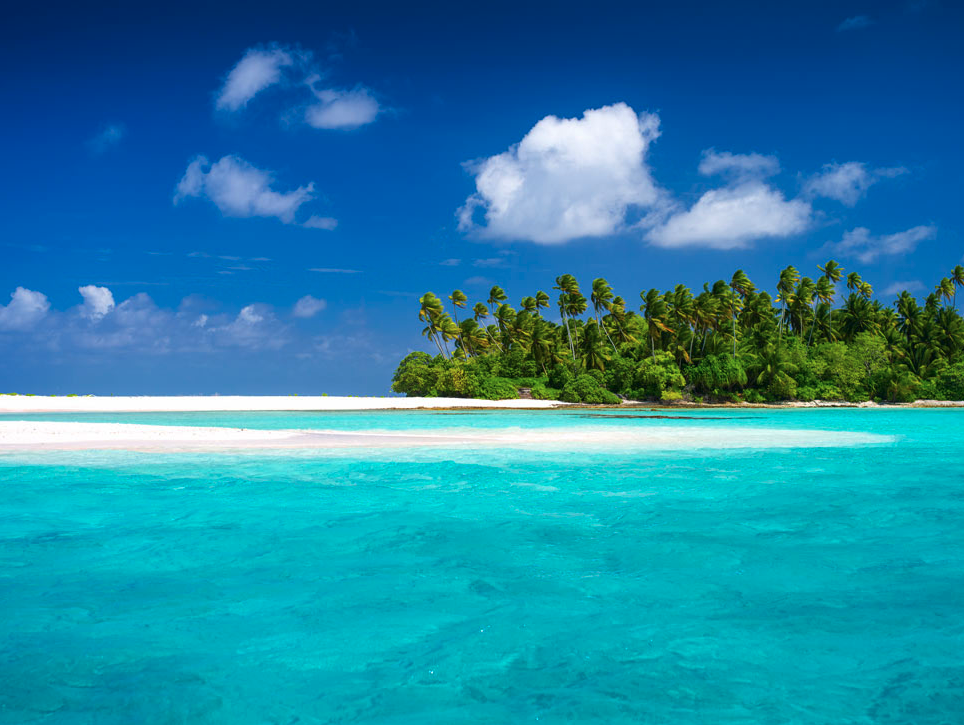Kiribati / Republic of Kiribati – Let’s explore here
What’s it like in Kiribati?
Kiribati is a stunningly beautiful island country composed of 32 atolls and a coral island that lies in the west called Banaba. The land area of Kiribati is about 1½ times the size of the Isle of man, England, UK. The population is only 121,000 and half live on one atoll – the capital, Tarawa.
Tarawa has a large lagoon, 193 square miles (500 square kilometres) in area, and a wide reef. On South Tarawa, where most of the population lives, a causeway has been created to form a single strip of land from the west to the northeast. North Tarawa consists of a string of islets which are separated by wide channels that are crossed at low tide. Only Buota is connected by road to South Tarawa, via a bridge.
The highest point in Kiribati is on Banaba island, at 266 ft (81 m). Having been mined for over 80 years, the centre of Banaba no longer has any soil and is uninhabitable. There are now only 330 people living on Banaba and any woodland is now limited to the coastal area.
By the way, Kiribati is pronounced KIRR-i-bass.

A bit about the history of Kiribati
Early History and Settlement
Kiribati, an island nation in the central Pacific Ocean, was first settled by Austronesian-speaking peoples over 3,000 years ago. The islands were originally settled by Polynesian navigators who arrived from south east Asia and the surrounding Pacific regions. These early settlers formed a traditional, island based society with a focus on fishing and agriculture.
European Exploration and British Colonization
The first recorded European contact with Kiribati occurred in 1606 when Spanish explorer Pedro Fernández de Quirós sighted the islands. In the 19th century, British explorers and missionaries arrived in the region. In 1892, the islands of Kiribati were formally annexed by the British and became part of the British Gilbert and Ellice Islands colony. The islands were administered as part of a larger British protectorate, with colonial interests focused on resources such as guano and copra.
World War II and Strategic Importance
During World War II, Kiribati’s islands, particularly Tarawa, were of strategic importance. The Battle of Tarawa in 1943 was a significant battle between US forces and the Japanese Imperial Army. It marked a turning point in the Pacific campaign and resulted in heavy casualties on both sides. The war had lasting effects on the islands, leaving behind physical and social scars.
Path to Independence
After World War II, Kiribati became part of the British Pacific Territories. Following a process of decolonisation in the mid 20th century, the Gilbert Islands, as Kiribati was then known, began moving toward self government. In 1971, it gained the status of a self governing territory, and by 1979, Kiribati officially became an independent nation on July 12.
Modern Kiribati
Today, Kiribati is an independent republic, with a focus on environmental sustainability and climate change mitigation. The nation faces significant challenges due to its low lying geography, which makes it highly vulnerable to rising sea levels caused by global warming. The government of Kiribati continues to advocate for international action on climate change while preserving its cultural heritage and fostering economic development, particularly through fishing and tourism.

Kiribati road trip
We haven’t finished our planning for our road trip through Kiribati yet. When we do though, we’ll post it here, and in the blog.
Hopefully our journey will improve our knowledge of this intriguing and beautiful country, and enable us to meet some interesting people. We’ll be updating this page at that time – don’t forget to check back 🙂
What’s it like to drive in Kiribati?
They drive on the left hand side of the road in Kiribati.
We’ve also created a dedicated page to driving abroad, which you might find helpful 🙂
What currency do they use in Kiribati?
In Kiribati they use the Australian dollar. The use of credit / debit cards is now widespread, although you should take cash in more remote areas. Travellers cheques are accepted in tourist areas. There are ATMs in major tourist areas.
You should make yourself aware of the amount that your bank charges you for using credit and debit cards abroad. Often credit cards are cheaper for purchasing items directly, and for withdrawing cash from ATMs.
What language do they speak in Kiribati?
They speak English and Gilbertese in Kiribati.
What time zone is Kiribati in?
Remember, when you’re planning your next trip to take a look at what time zone it’s in.
Do I need a visa to visit Kiribati?
We’ve created a dedicated, more comprehensive page on visas, which you should find helpful. Check it out!
Is wild camping legal in Kiribati?
No, wild camping is illegal in Kiribati.
What plug / socket type do they use in Kiribati?

In Kiribati they use plug / socket type I.
Health issues in Kiribati
Is it safe to drink water in Kiribati?
No, it is not safe to drink tap water in Kiribati. Bottled water is readily available throughout the country.
What vaccinations are required for Kiribati?
This NHS website is kept up to date with all relevant information on vaccinations in Kiribati.
Phones in Kiribati
What is the country calling code for Kiribati?
The country calling code for Kiribati is +686
What are the emergency phone numbers in Kiribati?
- The emergency number for police in Kiribati is: 100 / 192 / 999
- In Kiribati, the emergency number for ambulance is: 100 / 194 / 195 / 999
- The emergency number for fire in Kiribati is: 100 / 193 / 999
If you’ve got some useful info that you’d like to share, let us know!
And don’t forget to check out all the other pictures!
